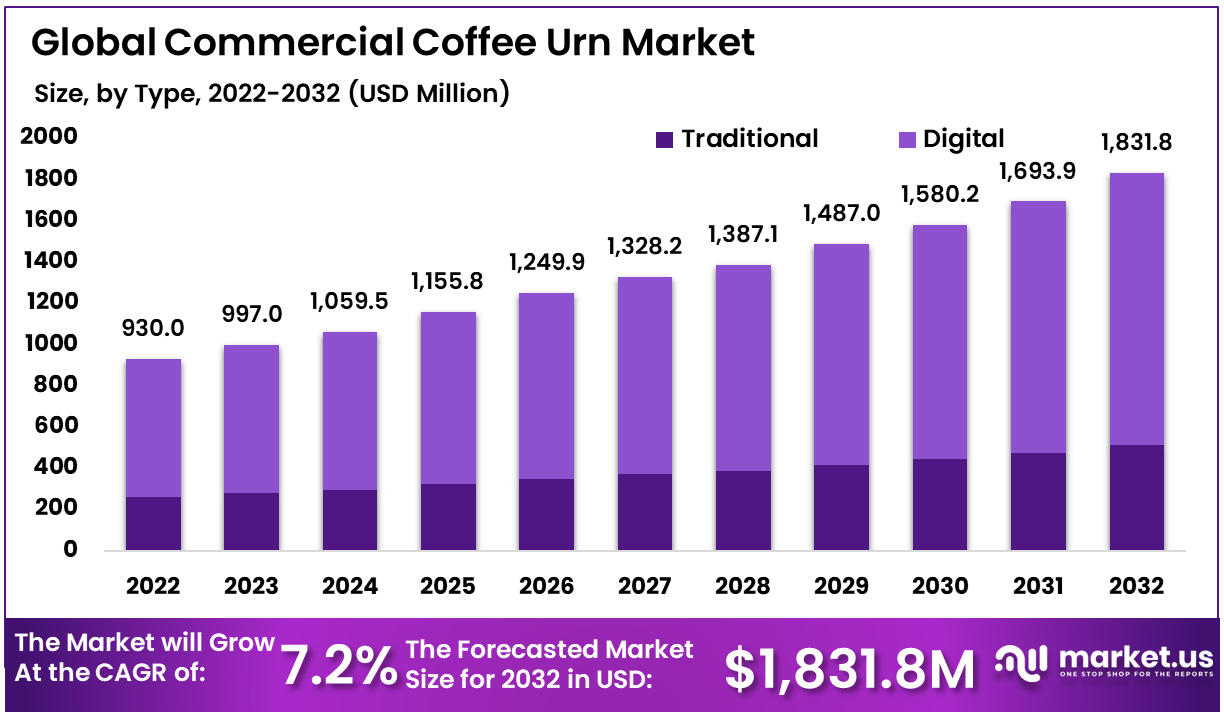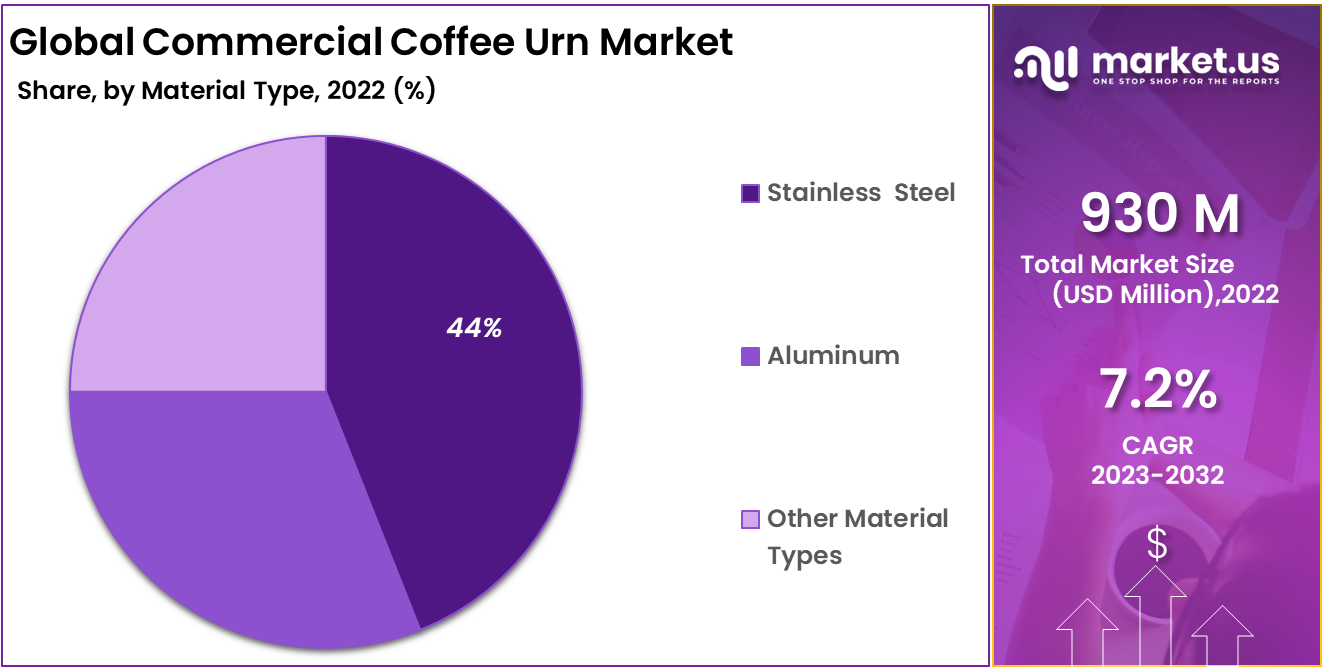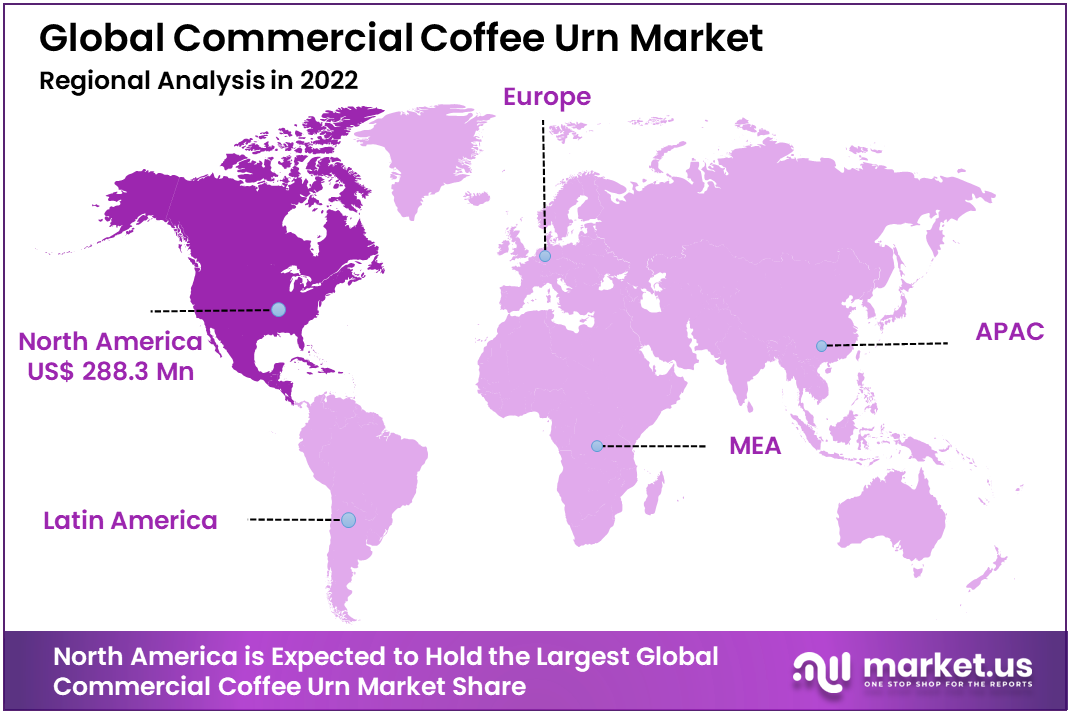Global Commercial Coffee Urn Market By Type (Traditional, Digital), By Capacity (30 - 45 Cups, 46 - 65 Cups, 66 - 100 Cups, 101 - 120 Cups, and More Than 120 Cups), By Material Type (Stainless Steel, Aluminum, and Other Material Types) By Style, By Features, By Distribution Channel, By Region and Companies - Industry Segment Outlook, Market Assessment, Competition Scenario, Trends, and Forecast 2023-2032
- Published date: Oct 2023
- Report ID: 106987
- Number of Pages: 239
- Format:
- keyboard_arrow_up
Quick Navigation
- Report Overview
- Key Takeaways
- Driving Factors
- Restraining Factors
- Growth Opportunities
- Latest Trends
- By Type Analysis
- By Capacity Analysis
- By Material Type Analysis
- By Style Analysis
- By Features Analysis
- By Distribution Channel Analysis
- Global Commercial Coffee Urn Market Key Segmentation:
- Geopolitics and Recession Impact Analysis
- Regional Analysis
- Market Share & Key Players Analysis
- Report Scope:
Report Overview
The Global Commercial Coffee Urn Market size is expected to be worth around USD 1831.8 Billion by 2032, growing at a CAGR of 7.20% during the forecast period from 2023 to 2032.
Introduction
The commercial coffee urn market has witnessed significant growth and evolution in recent years, driven by the soaring demand for efficient and convenient beverage dispensing results in different industries. Catering to the requirements of restaurants, cafes, event spaces, corporate offices, and hospitality establishments, commercial coffee urns have become indispensable appliances for large-scale coffee preparation and distribution.
These urns are designed to offer rapid brewing, highest capacity storage, and temperature retention, ensuring a steady supply of hot and freshly brewed coffee for diverse gatherings and service scenarios. With advancements in technology, smart commercial coffee urns often come equipped with user-friendly controls, durable construction, and energy-efficient features, appealing to businesses aiming to enhance customer satisfaction and streamline their beverage service operations.

Actual Numbers Might Vary in the Final Report
Key Takeaways
- In 2022, the global commercial coffee urn market was valued at USD 930 Million.
- By type, the digital held a major market share of 72% in 2022.
- By capacity, the 46 – 65 cups held a major market share of 42%.
- By material type, stainless steel held a major market share in 2022.
- By style, the market is segmented into double wall and single wall.
- By distribution channel, the online stores segmented held the largest share of the market.
- In 2022, North America dominated the market with the highest revenue share of 31%.
- One of the most significant driving forces in the rise in demand for coffee-based beverages.
- Key players include Bon Chef Inc., Coffee Pro EQ, Hamilton Beach Brands Inc., and Others.
Driving Factors
Rise in Demand for Coffee-Based Beverages Across the Globe
The global commercial coffee urn market is influenced by a confluence of driving factors that shape its dynamics and growth trajectory. The main factors are the burgeoning cafe culture and the maximizing demand for coffee-based beverages across the globe. As consumers continue to seek diverse and premium coffee experiences, cafes, restaurants, and other commercial establishments are investing in the highest capacity coffee urns to meet this demand efficiently.
Additionally, the proliferation of corporate offices, hotels, and catering services has significantly maximized the need for larger-scale coffee preparation, further propelling the demand for commercial coffee urns. Technological advancements also play a vital role in the growth of the market.
Producers are consistently innovating to enhance the efficiency, durability, and user-friendliness of coffee urns, incorporating features like digital controls, energy-saving options, and advanced brewing mechanisms. This technological progress not only enhances the brewing process but also aligns with sustainability trends, appealing to eco-conscious consumers and businesses.
Restraining Factors
Balancing Growth Potential with Constraints
The world’s commercial coffee urn market, although having a significant growth potential, isn’t without limitations. One of the main problems is the increasing consciousness and desire to drink healthier alternatives, which have prompted some consumers and companies to rethink their excessive consumption of coffee.
Additionally, growing awareness of the environmental impact has forced the coffee sector to embrace eco-friendly methods, such as the reduction of items that are only used once, such as disposable coffee cups that are commonly associated with the use of coffee urns. In addition, economic turbulences and uncertainty can impact the buying power of firms, which could lead to a decrease in investment in equipment that isn’t essential, such as coffee urns. Growth in the market could be impeded by the presence of established players, creating obstacles for new players to make a mark on the market.
To succeed in the current market, companies as well as businesses operating within the coffee urn commercial market, have to overcome these constraints with the help of innovation, sustainable efforts, and adapting to evolving consumer habits.
Growth Opportunities
The global commercial coffee urns market presents a promising landscape with substantial growth opportunities on the horizon. The escalating demand for quality coffee across diverse business sectors, such as hospitality, corporate offices, and food service establishments, is a primary driver of this growth. As consumer preferences shift towards premium coffee experiences, the need for efficient and reliable coffee urns becomes paramount.
Moreover, the increasing prevalence of coffee culture and the proliferation of specialty coffee shops worldwide further fuel the demand for advanced and specialized coffee brewing equipment like commercial coffee urns. Innovation is another key avenue for growth in this market. Manufacturers are continually exploring advancements in technology, design, and features to enhance user experience and streamline operations.
Latest Trends
The global market for commercial coffee urns is currently witnessing several intriguing trends that are shaping the industry’s landscape. One prominent trend is the increasing emphasis on sustainability and eco-friendliness. As environmental awareness grows, manufacturers are striving to develop coffee urns that are made from recyclable materials, have energy-efficient features, and reduce overall waste generation.
This aligns with the broader push towards responsible business practices and resonates with environmentally conscious consumers. Furthermore, smart technology integration is gaining momentum within the commercial coffee urn market. Smart coffee urns equipped with IoT capabilities are becoming more prevalent, allowing users to remotely monitor brewing processes, adjust settings, and receive real-time notifications about maintenance and operation.
By Type Analysis
The Digital Commercial Coffee Urns Type is Expected to Dominate This Market
Based on type, the market for the commercial coffee urn is classified into traditional and digital. The digital commercial coffee urns segment is dominating the market share with 72%. The dominant position of the digital sector in the market for commercial coffee urns can be explained by a variety of significant factors that have contributed to the market’s popularity over recent years.
Integration of modern technology in coffee urns has changed the brewing process by allowing precise control of different brewing parameters like temperatures, brewing times as well and the ratio of coffee to water. This degree of personalization does not just guarantee a consistently excellent cup of coffee but also accommodates the various preferences of consumers.
Furthermore, COVID-19 played an important impact in the rapid adoption of coffee urns that are digital. A focus on cleanliness and minimizing contact led firms to search for options that allow for control via touch as well as remote monitoring. Modern coffee urns featuring features like programmable cycle brewing and remote controls enabled establishments to adhere to strict standards of hygiene while maximizing the efficiency of their operations.
By Capacity Analysis
46 – 65 Cups Capacity Dominate This Market
Based on capacity, the market for commercial coffee urns is classified into 30 – 45 cups, 46 – 65 cups, 66 – 100 cups, 101 – 120 cups, and more than 120 cups. The 46 – 65 cups segment is dominating the market share with 42%. Within the different capacity groups of the market for commercial coffee urns, The 46-65 cups segment has become the most popular choice. It has caught the attention of business owners due to a variety of compelling motives.
The capacity range can strike an appropriate balance between catering for small gatherings while also offering flexibility for various venues. It can accommodate the needs of small-scale and larger events; the 46-65 cup segment is a great fit for a variety of establishments that offer food services, ranging from cafes, restaurants, and even catering facilities and conference centers.
Additionally, the capacity range is in line with current fashions in social gatherings as well as the size of events. It’s able to handle intimate gatherings while scaling into mid-sized gatherings, allowing it to adapt to the diverse requirements of clients. The COVID-19 virus played an influence in changing the dynamics of events, and many people prefer smaller, more controlled gatherings that this segment will easily handle.
By Material Type Analysis
Stainless Steel Material Type is Expected to Dominate This Market
Based on material type, the market for commercial coffee urns is classified into stainless steel, aluminum, and other material types. The dominance of the stainless steel segment in the market for commercial coffee urns can be attributed to a combination of factors that make it the preferred choice among businesses and consumers alike. Stainless steel stands out as a premium material due to its exceptional properties, making it highly suitable for the demanding requirements of commercial environments. First and foremost, stainless steel boasts remarkable durability and longevity.
In bustling commercial settings such as restaurants, hotels, or event venues, coffee urns need to endure constant use and frequent handling. Stainless steel’s resistance to corrosion, rust, and wear ensures that these urns maintain their sleek appearance and functionality over time, even with exposure to moisture and frequent cleaning. Moreover, stainless steel’s non-reactive nature makes it ideal for food and beverage applications.
Coffee is acidic and can react with certain materials, altering the taste and quality of the brew. Stainless steel does not leach any unwanted flavors or chemicals into the coffee, preserving its taste and integrity. This quality is particularly crucial in the food service industry, where consistency in flavor is paramount.
By Style Analysis
According to fashion, the marketplace for commercial coffee urns can be classified as the categories of Double wall, and single wall. The Double Wall style of commercial coffee urns has been praised for its exceptional thermal insulation as well as its temperature retention capabilities. Built with two layers of materials that are typically stainless steel, they create an air space that functions as a barrier to heat.
The innovative design ensures beverages are served hot at the best serving temperature over long durations, which makes it ideal for locations where coffee is offered for hours in buffets, conferences, and gatherings. This Double Wall design not only restricts heat loss but keeps the outside from getting too hot for a feel, which increases the security of guests. In contrast, it is the Single Wall style of commercial coffee urns that offers a more compact and light choice.
The urns are constructed only of one layer of materials and tend to be smaller in size. They’re ideal for small businesses that have coffee needs on occasion or storage spaces that are limited. Single-wall urns are easy to move and put up and are ideal for small catering businesses, cafes, or casual gatherings. Though they might not provide the same amount of heat retention that Double Wall urns, their ease of use and simplicity make them an ideal option for fast service occasions.
By Features Analysis
Based on features, the market for commercial coffee urns is classified into NSF-listed sight gauges. NSF-listed urns adhere to rigorous quality and safety standards set by the National Sanitation Foundation (NSF), ensuring optimal hygiene and reliability for food service establishments. On the other hand, sight gauge urns feature transparent level indicators, allowing users to easily monitor the remaining coffee volume.
This feature proves valuable in high-demand settings, enabling timely refills to maintain a consistent supply of coffee. Both NSF-listed and sight gauge coffee urns exemplify how the market addresses diverse needs within the commercial coffee industry, prioritizing safety, efficiency, and convenience.
By Distribution Channel Analysis
Online Distribution Channel Dominate in This Market
Based on the distribution channel, the market for commercial coffee urns is classified into online and offline. In recent years, the online segment has emerged as a dominant force in this market, largely due to several compelling factors. Online platforms offer unparalleled convenience, allowing buyers to explore a wide array of coffee urn options from the comfort of their own space.
The ease of comparing features, prices, and reviews across different brands and models contributes to informed purchasing decisions. Additionally, online platforms provide a global reach, enabling buyers to access a diverse range of products that might not be available locally. The digital landscape also facilitates direct interaction between manufacturers, sellers, and customers through various online channels, ensuring personalized assistance and prompt query resolution.

Global Commercial Coffee Urn Market Key Segmentation:
Based on Type
- Traditional
- Digital
Based on Capacity
- 30 – 45 Cups
- 46 – 65 Cups
- 66 – 100 Cups
- 101 – 120 Cups
- More Than 120 Cups
Based on Material Type
- Stainless Steel
- Aluminum
- Other Material Types
Based on Style
- Double Wall
- Single Wall
Based on Features
- NSF Listed
- Sight Gauge
Based on the Distribution Channel
- Online
- Offline
Geopolitics and Recession Impact Analysis
Supply Chain Disruptions: Geopolitical tensions can disrupt global supply chains. For example, political unrest or strained relations between countries can affect the supply of raw materials like steel or electronic components, causing delays and increasing costs for manufacturers.
Tariffs and Trade Policies: Geopolitical decisions can result in tariffs or trade restrictions, affecting the cost of importing or exporting coffee urns. This could make products more expensive in certain markets, affecting demand.
Consumer Spending: In a recession, businesses, especially in the hospitality sector, may reduce spending on non-essential items, which could include upgrades to commercial coffee urns.
Access to Capital: Economic downturns often lead to tightened credit markets. Businesses might find it challenging to secure loans for capital expenditures, including investment in new coffee urns.
Regional Analysis
North America dominated the global market in terms of revenue share in 2022, with more than 31%. The region is expected to remain dominant throughout the forecast time. The region’s well-established and vibrant food service industry, coupled with a deeply ingrained coffee culture, has created a substantial demand for high-quality coffee brewing equipment. The United States and Canada, as key players in North America, possess a large number of cafes, restaurants, hotels, and catering businesses that rely heavily on efficient and dependable coffee urns to meet customer expectations.
North America’s technological advancements and widespread access to e-commerce platforms have facilitated the seamless distribution and availability of commercial coffee urns. Online retailing has allowed for easy comparison shopping, quick delivery, and a broader selection of products, enabling businesses to access the latest and most suitable coffee urn models for their specific needs.

Key Regions and Countries Covered in this Report:
- North America
- The US
- Canada
- Europe
- Germany
- France
- The UK
- Spain
- Italy
- Russia & CIS
- Rest of Europe
- APAC
- China
- Japan
- South Korea
- India
- ASEAN
- Rest of APAC
- Latin America
- Brazil
- Mexico
- Rest of Latin America
- Middle East & Africa
- GCC
- South Africa
- United Arab Emirates
The Global Commercial Coffee Urn Market is extremely dynamic. All major companies are trying to increase their market share. Bon Chef Inc., Coffee Pro EQ, and Hamilton Beach Brands Inc. are major market players across the globe.
Market Key Players:
- Bon Chef Inc.
- BUNN
- Coffee Pro EQ
- Cresimo
- Hamilton Beach Brands Inc.
- Home Craft
- NESCO
- WestBend
- Other Key Players
Report Scope:
Report Features Description Market Value (2022) US$ 930 Mn Forecast Revenue (2032) US$ 1,831.8 Mn CAGR (2023-2032) 7.2% Base Year for Estimation 2022 Historic Period 2016-2022 Forecast Period 2023-2032 Report Coverage Revenue Forecast, Market Dynamics, COVID-19 Impact, Competitive Landscape, Recent Developments Segments Covered By Type-Traditional, and Digital; By Capacity-30 – 45 Cups, 46 – 65 Cups, 66 – 100 Cups, 101 – 120 Cups, and More Than 120 Cups; By Material Type-Stainless Steel, Aluminum, and Other Material Types; By Style- Double Wall, Single Wall, By Features- NSF Listed, Sight Gauge, By Distribution Channel- Offline, and Online. Regional Analysis North America: The US and Canada; Europe: Germany, France, The UK, Italy, Spain, Russia & CIS, and the Rest of Europe; APAC: China, Japan, South Korea, India, ASEAN, and the Rest of APAC, Latin America: Brazil, Mexico, and Rest of Latin America; Middle East & Africa: GCC, South Africa, United Arab Emirates, and Rest of Middle East & Africa Competitive Landscape Bon Chef Inc., BUNN, Coffee Pro EQ, Cresimo, Hamilton Beach Brands Inc., Home Craft, NESCO, WestBend, and Other Key Players Customization Scope Customization for segments, region/country-level will be provided. Moreover, additional customization can be done based on the requirements. Purchase Options We have three licenses to opt for Single User License, Multi-User License (Up to 5 Users), Corporate Use License (Unlimited User and Printable PDF) Frequently Asked Questions (FAQ)
What is the Commercial Coffee Urn Market Estimated During the Forecast Period 2023-2032?The Global Commercial Coffee Urn Market size is expected to be worth around USD 1831.8 Billion by 2032 during the forecast period.
What is the Commercial Coffee Urn Market Estimated CAGR During the Forecast Period 2023-2032?The Global Commercial Coffee Urn Market size is expected to grow at a CAGR of 7.20% during the forecast period from 2023 to 2032.
 Commercial Coffee Urn MarketPublished date: Oct 2023add_shopping_cartBuy Now get_appDownload Sample
Commercial Coffee Urn MarketPublished date: Oct 2023add_shopping_cartBuy Now get_appDownload Sample - Bon Chef Inc.
- BUNN
- Coffee Pro EQ
- Cresimo
- Hamilton Beach Brands Inc.
- Home Craft
- NESCO
- WestBend
- Other Key Players
- settingsSettings
Our Clients
| Single User $4,599 $3,499 USD / per unit save 24% | Multi User $5,999 $4,299 USD / per unit save 28% | Corporate User $7,299 $4,999 USD / per unit save 32% | |
|---|---|---|---|
| e-Access | |||
| Report Library Access | |||
| Data Set (Excel) | |||
| Company Profile Library Access | |||
| Interactive Dashboard | |||
| Free Custumization | No | up to 10 hrs work | up to 30 hrs work |
| Accessibility | 1 User | 2-5 User | Unlimited |
| Analyst Support | up to 20 hrs | up to 40 hrs | up to 50 hrs |
| Benefit | Up to 20% off on next purchase | Up to 25% off on next purchase | Up to 30% off on next purchase |
| Buy Now ($ 3,499) | Buy Now ($ 4,299) | Buy Now ($ 4,999) |












